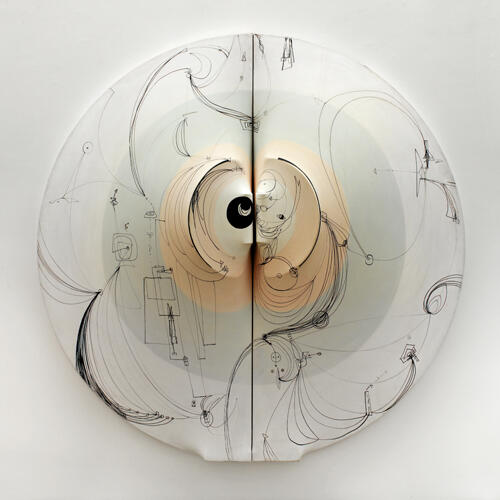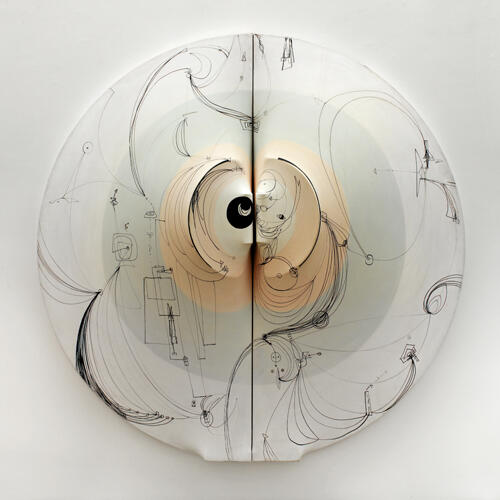Zilia Zánchez: an Approach to the Topographies of Desire
Beyond the vernacular-artistic manifestations that strive to understand what is produced in and from the Caribbean as an eclectic amalgamation of ancestral and cultural links, the work of artist Zilia Sánchez (1926) has developed amidst notions of rupture, which have a long tradition in the modern and contemporary art production of Latin America.

Space does not allow me to digress into historical or academic disquisitions, but let me briefly note that an “encoded aesthetics” (implicitly lesbian) seems to be present in Sánchez's work. Encoded, insofar as it tries to escape—surreptitiously, it seems—from the social and cultural traditions that represent sexism, heterosexism, and homophobia. In any case, although the majority of critics associate her works with different aspects or moments of European or American abstraction—alongside Dubuffet, Fontana, Tapies, or minimalism in general—the inescapable presence of the body in her work aligns it, in my opinion, with other sources and concerns, not always or not exclusively related to a will to formalize or severely refine eroticism. In fact, this recurring effort to cover what the work clearly shows is a characteristic of the majority of the few critics who have addressed her work, except, perhaps, in the case of Severo Sarduy.
As Rudi Bleys explains, “Abstraction being a peculiarly metropolitan product, reflecting values of individual emancipation, sexual liberation and public tolerance, evidently seemed more attractive in the eyes of local Puerto Rican artists wanting to escape and, often, migrating to Miami, New York or elsewhere in North America or Europe.” [1] Sánchez's is a parallel case, although hers is the reverse itinerary: from Cuba, where she was born, to Madrid, New York, and finally Puerto Rico, where she has lived and worked since the early 1970s.
In the context of "abstraction," we need not turn to Nelly Richards to understand that neutrality in artistic value judgments only serves to benefit and reify the hegemonic discourse of the universal-masculine. But to start with, Sánchez's oeuvre not only challenges the conventional concept of frontal view typical of abstract painting—by interrupting the line of vision and disarticulating the frontality of the masculine gaze—but also eliminates the possibility of completely assuming or “capturing” the object, which, in turn, potentiates the feminine as symbol of change in search of a means to put into place an alternative and counter-dominant strategy.
In fairness, we must admit that all the critics agree on the obvious differences between Sánchez's frameless and modular constructions in wood and canvas and the formal abstractions of minimalism. Even when Sánchez's structures highlight abstraction, sequencing, or repetition, they always take the shape of, or simulate, body parts that approach or suggest an epidermal understanding of sexuality. Benigno Trigo, in particular, insists on this epidermal aspect of Sánchez's work—surface-bound, tense, and extended— in a brilliant essay on the influential Puerto Rican magazine Zona de Carga y Descarga[2] (Loading and Unloading Zone), a magazine in which Sánchez participated as a designer, together with friends and colleagues such as Marta Traba and Severo Sarduy. For Trigo, that surface unequivocally represents—when it does not imitate directly—encounters, contacts, caresses, creases, and folds in various female sexual body parts, whether they be abstracted or stylized details aimed at suggesting nipples, navels, vulvas, labia, clitorises, or anuses that fold and enter into other spaces and project themselves onto other contact surfaces. Some of her titles— Las Troyanas (The Trojan Women), Las Amazonas (The Amazons), Topología erotica (Erotic Topology)—are quite revealing.
Then again, Marta Traba, the legendary, feminist-oriented Argentine critic, prefers to utilize Sánchez's work to illustrate a simplistic and reductionist conception of the difference between “eroticism” and “pornography”: “One feels, for instance, that Sánchez's magnificent Antigone is, somehow, intimately related to the female genitals, but it would be impossible to assert that the feelings derived from the Antigone are the same as those evoked by the sustained contemplation of a pornographic image in an Andy Warhol film, because the eroticism in Sánchez's work attempts to persuade and convince in the same measure as Warhol's pornography intends to strike and impact[3],” Traba assures. In Traba's opinion, “eroticism [has] nourished, for centuries, Oriental art …and pornography [is ] a coveted product of Western capitalism, and specifically, of North American civilization.” Yet Traba heterosexualizes Sánchez's oeuvre. As Bleys understands it, Traba reduces the artist's language to a mere figuration of male-female penetration. In effect, the Argentine writer asserts that “[Sánchez] creates a constant rhythmical connotation of the subject of sex, based fundamentally on the counterpoint of erections and excavations” (author’s emphasis).
Along the same lines, others re-appropriate Sánchez's work for the realm of heteronormality and de-sexualize the work as a product of intellectual eroticism or erotic intellectuality. Fortunately, Traba was sufficiently lucid and incisive to understand and assume that, beyond her own generational approach, the “play” in Sánchez's oeuvre “is very far from the simple visual divertimento of common and ordinary optic modules.”
Sarduy, by contrast, refers to the “space of tactility”, suggesting—in our generational language—at least one lesbian, or queer, eroticism. Writing for the catalogue of one of Sánchez's exhibitions [4], Sarduy implicitly criticizes minimalism and the French nouveau roman for their obsession with a pure and abstract object, and for abandoning the “tactile” space on which Sánchez's topologies insist. In effect, although not yet daring to assign a name to it, Sarduy speaks to us of “voluptuousness inventing its possibilities.”[5] Sarduy understood the term “topology” in its medical sense, which makes reference to the anatomic structure of an area or a body part, and which suggests organic and somewhat abstract forms. In his book, Escrito sobre un cuerpo (Written on a body), the ambiguity of the term allows Sarduy to consider a “zone” with the necessary flexibility and the necessary ability to sustain inversions, changes, and transformations; an unstable surface or topology of signification in which the parts in tension establish what he understands as “erotic [6].”
Sánchez's eroticism is unmistakable, even though, in this unexpected recent re-discovery of her work propitiated by Artist Space, the US criticism barely makes reference to it in passing. The relationship of Sánchez’s topologies with the ambiente of the gay movement in New York to which Bleys refers is still to be explored, but it will undoubtedly offer new perspectives and information that will help us to understand, and will offer an alternative contextualization for, the homotextuality of Sánchez's oeuvre.
Gratitude is certainly due to Stefan Kalmár and Richard Birkett for their having delighted us, with one of the best exhibitions of the year outside of the regular spaces of New York's canonical sources.
[1] Rudi Bleys, “Images of Ambiente: Homotextuality and Latin American Art, 1810-today,” Continuum, 2000, p. 81
[2] Benigno Trigo, “Zona. Carga y Descarga. Minor Literature in a Penal Colony,” MLN,
(John Hopkins University) Volume 124, Number 2, March 2009
[3] All the references to Marta Traba are excerpted from her article included in Zona magazine: Marta Traba, "Eroticism and Communication." Zona de Carga y Descarga, San Juan, Puerto Rico, November - December, 1972, p. 11.
[4] Following Trigo’s research, Sánchez and Sarduy first became involved in the Cuban newspaper Ciclón, and Sarduy already wrote about Sánchez’s work in the catalogue that accompanied her second solo show at Galería Cubana. In 1970, Sánchez had an exhibition at Sarduy Gallery, whose owner was Rosa María Sarduy, Severo’s cousin. That same year, Sarduy wrote the prologue for the catalogue that accompanied Sánchez’ exhibition at the Museum of the University of Puerto Rico.
[5] Severo Sarduy, “Las ‘topologías eróticas’ de Zilia Sánchez.” Estructuras en secuencias. Catalogue for Zilia Sánchez’s exhibition at the Museum of the University of Puerto Rico. 3 Unnumbered pages, 1970.
[6] Severo Sarduy, Escrito sobre un cuerpo; ensayos de crítica. Buenos Aires, Editorial Sudamericana, p. 46, 1969.
-
 Lunar con Tatuaje (Moon with Tattoo), c. 1968-96
Lunar con Tatuaje (Moon with Tattoo), c. 1968-96
Acrylic on stretched canvas - 71 x 72 x 12 inches (180.3 x 182.9 x 30.5 cm)
All Images: Copyright of the Artist, Courtesy of Galerie Lelong, New York -
 Lunar V (Moon V), c. 1973
Lunar V (Moon V), c. 1973
Acrylic on stretched canvas
74.75 x 79.5 x 10 inches (189.9 x 201.9 x 25.4 cm) -
 Troyanas, díptico (Trojans, diptych), 1975
Troyanas, díptico (Trojans, diptych), 1975
Acrylic on stretched canvas
67.5 x 38 x 6 inches (171.5 x 96.5 x 15.2 cm)




